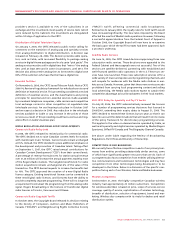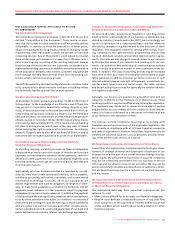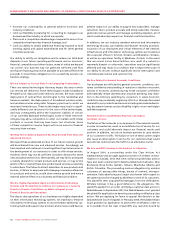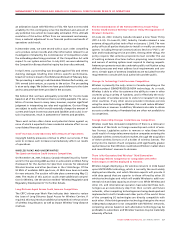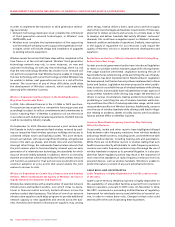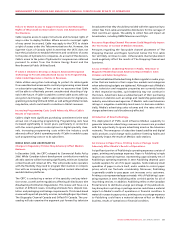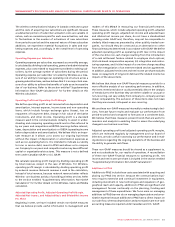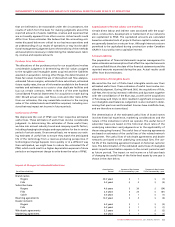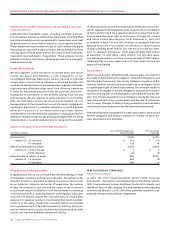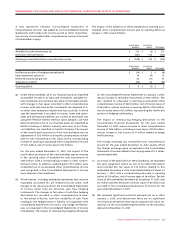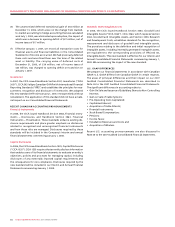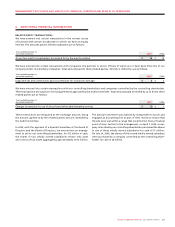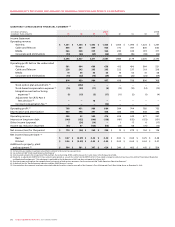Rogers 2007 Annual Report Download - page 66
Download and view the complete annual report
Please find page 66 of the 2007 Rogers annual report below. You can navigate through the pages in the report by either clicking on the pages listed below, or by using the keyword search tool below to find specific information within the annual report.
62 ROGERS COMMUNICATIONS INC. 2007 ANNUAL REPORT
MANAGEMENT’S DISCUSSION AND ANALYSIS OF FINANCIAL CONDITION AND RESULTS OF OPERATIONS
The additions to PP&E before related changes to non-cash working
capital represent PP&E that we actually took title to in the period.
Accordingly, for purposes of comparing our PP&E outlays, we
believe that additions to PP&E before related changes to non-cash
working capital best reflec t our cost of PP&E in a period, and provide
a more accurate determination for period-to-period comparisons.
CRITIC AL ACCOUNTING POLICIES
This MD&A has been prepared with reference to our 2007 Audited
Consolidated Financial Statements and Notes thereto, which have
been prepared in accordance with Canadian GAAP. The Audit
Committee of our Board reviews our accounting policies, reviews
all quarterly and annual filings, and recommends approval of our
annual financial statements to our Board. For a detailed discussion
of our accounting policies, see Note 2 to the 2007 Audited
Consolidated Financial Statements. In addition, a discussion of new
accounting standards adopted by us and critical accounting esti-
mates are discussed in the sections “New Accounting Standards”
and “Critical Accounting Estimates”, respectively.
Revenue Recognition
Revenue is categorized into the following types, the majority of
which are recurring in nature on a monthly basis from ongoing
relationships, contractual or otherwise, with our subscribers:
• Monthlysubscriberfeesinconnectionwithwirelessandwireline
services, cable, telephony, Internet services, rental of equipment,
network services and media subscriptions are recorded as rev-
enue on a pro rata basis as the service is provided;
• Revenue from airtime, roaming, long-distance and optional
services, pay-per-use services, video rentals and other sales of
products are recorded as revenue as the services or products are
delivered;
• Revenue from the sale of wireless and cable equipment is
recorded when the equipment is delivered and accepted by
the independent dealer or subscriber in the case of direct sales.
Equipment subsidies related to new and existing subscribers are
recorded as a reduction of equipment revenues;
• Installationfeesandactivationfeeschargedtosubscribersdonot
meet the criteria as a separate unit of accounting. As a result, in
Wireless, these fees are recorded as part of equipment revenue
and, in the case of Cable, are deferred and amortized over the
related service period. The related service period for Cable ranges
from 26 to 48 months, based on subscriber disconnects, transfers
of service and moves. Incremental direct installation costs related
to re-connects are deferred to the extent of deferred installation
fees and amortized over the same period as these related instal-
lation fees. New connect installation costs are capitalized to PP&E
and amortized over the useful life of the related assets;
• Advertisingrevenueisrecordedintheperiodtheadvertisingairs
on the Company’s radio or television stations and the period in
which advertising is featured in the Company’s publications;
• Monthlysubscriptionrevenuesreceivedbytelevisionstationsfor
subscriptions from cable and satellite providers are recorded in
the month in which they are earned;
• BlueJays’revenuefromhomegameadmissionandconcessionsis
recognized as the related games are played during the baseball
regular season. Revenue from radio and television agreements is
recorded at the time the related games are aired. The Blue Jays
also receive revenue from the Major League Baseball Revenue
Sharing Agreement, which distributes funds to and from member
clubs, based on each club’s revenues. This revenue is recognized
in the season in which it is earned, when the amount is estimable
and collectibility is reasonably assured; and
• Discountsprovidedtocustomersrelatedtocombinedpurchases
of Wireless, Cable, and Media products and services are charged
directly to the revenue for the products and services to which
they relate.
We offer certain products and services as part of multiple deliverable
arrangements. We divide multiple deliverable arrangements into
separate units of accounting. Components of multiple deliverable
arrangements are separately accounted for provided the delivered
elements have stand-alone value to the customers and the fair
value of any undelivered elements can be objectively and reliably
determined. Consideration for these units is measured and allo-
cated amongst the accounting units based upon their fair values
and our relevant revenue recognition policies are applied to them.
We recognize revenue once persuasive evidence of an arrangement
exists, delivery has occurred or services have been rendered, fees
are fixed and determinable and collectibility is reasonably assured.
Unearned revenue includes subscriber deposits, installation fees
and amounts received from subscribers related to services and sub-
scriptions to be provided in future periods.
Subscriber Acquisition and Retention Costs
We operate within a highly-competitive industry and generally
incur significant costs to attract new subscribers and retain exist-
ing subscribers. All sales and marketing expenditures related to
subscriber acquisitions, retention and contract renewals, such as
commissions, and the cost associated with the sale of customer
premises equipment, are expensed as incurred.
A large percentage of the subscriber acquisition and retention
costs, such as equipment subsidies and commissions, are variable in
nature and directly related to the acquisition or renewal of a sub-
scriber. In addition, subscriber acquisition and retention costs on a
per subscriber acquired basis fluctuate based on the success of pro-
motional activity and the seasonality of the business. Accordingly,
if we experience significant growth in subscriber activations or
renewals during a period, expenses for that period will increase.
Capitalization of Direct Labour and Overhead
During construction of new assets, direct costs plus a portion of
applicable overhead costs are capitalized. Repairs and maintenance
expenditures are charged to operating expenses as incurred.
CRITIC AL ACCOUNTING ESTIMATES
This MD&A has been prepared with reference to our 2007 Audited
Consolidated Financial Statements and Notes thereto, which have
been prepared in accordance with Canadian GAAP. The prepara-
tion of these financial statements requires management to make
estimates and assumptions that affect the reported amounts of
assets, liabilities, revenues and expenses, and the related disclosure
of contingent assets and liabilities. These estimates are based on
management’s historical experience and various other assumptions



